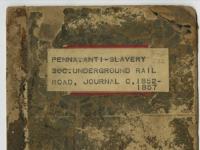In 1852, during a meeting of the Pennsylvania Abolition Society, a new Vigilance Committee was created with Robert Purvis as the head of the General Committee and William Still as the chairman. William Still documented the cases that the Vigilance Committee handled from 1852-1857. Through the analysis of Still’s journal, students will explore the personal accounts of fugitive slaves and will build a profile of those individuals who either came through Philadelphia or stayed in the city and sought the services of the Vigilance Committee. Still's compelling documentation of the names, ages, physical descriptions, treatment, motivations for seeking freedom, skills, and the details of the physical and emotional journeys of fugitive slaves provide rich content for discussion about slavery and escape. The Vigilance Committee expenditures as well as the Still journal reveal another aspect of the Underground Railroad, the financial cost of caring. This lesson is designed to have students understand the Underground Railroad as an intricate system powered, on the one hand, by personal motivation and determination for freedom, but also supported and aided by individuals in the larger, particularly free black, communities.
Fugitive Slaves: The Cost of Caring
Fugitive Slaves: The Cost of Caring
Essential Questions
Objectives
Students will be able to:
- Assess the impact slave laws in Pennsylvania in the antebellum period and assess their implications on the free black, slave, and the general populations of Philadelphia by discussing the risks both Fugitive Slaves and the Vigilance Committee took for freedom.
- Distinguish the characteristics of a fugitive slave traveling through Pennsylvania by analyzing the primary source journals of William Still, Chairman of the Vigilance Committee.
- Interpret how much it cost the Vigilance Committee to assist fugitive slaves by analyzing William Still’s expense book.
Primary Sources
Other Materials
Relevant excerpts from William Still journal
- Sept. 2, 1853 - John Walker- passing as a white man
- Sept. 23, 1853 and October 25, 1853- John Henry Hill - traveled via steamship
- Oct. 27, 1853- Mark Hamlet Thodgoff- advisable to send him away
- Nov. 2, 1853- Robt. Jackson- shot while escaping
- March 6, 1854- Sam'l Washington Johnson- importance of Uncle Tom's Cabin
- Aug. 28, 1854- Wesley Kinnard- helped by Harriet Tubman
- Sept. 8, 1854- John Henry Rickels- found his mother after 20 years
- Sept. 25, 1854- Chas. King & Robert White- hired out
- Oct. 21, 1854- Chas. Thompson- influenced by Uncle Tom's Cabin
- Nov. 2, 1854 and May 19, 1856- John Cannon- letter from New York
- Nov. 27, 1854- John Wesley Gibson- passing as a white man
- Dec. 21, 1854- Issac William, Henry Banks, Kit Nickless- broke out of jail
- Jan. 1, 1854- Peter Derrickson- benefit of his own labor
- March 1, 1855- Mary Epps, Joseph and Robert Robinson- sale of children, description of southern slave prison
- ------- Sam'l Nixon- a dentist
- April 27, 1855- Elias Jasper- skilled worker including daguerreotyping
- June 29, 1855- Richard Green- master tries to take mother's child
- Aug. 17, 1855- Elizabeth Banks- living in Pennsylvania for 2 years
- Dec. 11, 1855- Sam'l Green- living in Pennsylvania for 9 years
- Nov. 20, 1855- 21 arrivals- role of religion
- Nov. 22, 1855- Ann Maria Whims (Weems)- dressed like a man to escape
- Jan. 2, 1856- Robert Brown- swam the Potomac River
- Jan. 16, 1856- 5 arrivals- almost caught
- Jan. 29, 1856- Mary Jeffries, Mary Redden, Sarah Redden- living in Philadelphia for several years
Expense Book, Vigilance Committee of Philadelphia, 1854-1855
Student Worksheet: Cost of Caring
Suggested Instructional Procedures
1. Drawing on information from the background reading, teachers should lead a discussion accompanied by a presentation discussing the northern racism and violence that demoralized Robert Purvis and quelled the Vigilant Committee.
a. The focus of the discussion should be on the riots of 1842.
b. During the presentation, the teacher should introduce William Still, the chairman of the Vigilance Committee from 1852-1857.
c. After being introduced to William Still, have students predict what might have influenced the revival of the organization in the 1850s
d. Responses might include increased sectional debate and conflict, the Compromise of 1850 and the Fugitive Slave Act, as well as the radicalization of the abolition movement.
2. Have students read through the journal excerpts and the Vigilance Committee expenditures. Teachers may decide not to use all of the journal entries provided. As students read the material, they should complete the worksheet.
a. After students have completed the readings and worksheet, students will be organized in small groups (3-4). These groups will be tasked with the job of developing a general composite of the fugitive slave. The groups will work together as the teacher circulates the room helping any group that might be stuck. Some ideas for students who are struggling: male or female, traveled in groups or alone, modes of transportation, reason for leaving, etc.
3. After the students are finished, the teacher will lead a focused discussion around questions number 8 and 9 from the student worksheet.
a.The teacher should discuss how Still's entries compare to the Vigilant Committee's documentation (Have the students think back to the previous lesson in the unit.)
b. As a class, student should discuss the risks in maintaining a detailed journal as well as highlight William Still’s reunification with his brother and the importance of documenting this information to reunite other families. In an extended response to be put in their journals, have students reflect upon what if any information about the UGRR was surprising, interesting, etc. The students should also incorporate the “cost of caring” and the intricate system of communication, transportation and aid that was the Underground Railroad. Responses should contain complete thoughts and should range from 2-3 handwritten pages.
Expansion Activities:
- In addition to answering the questions on the worksheet, teachers may choose to also have students map where these fugitive slaves came from. Provide an outline map of the eastern United States, an atlas and the journal excerpts. Have students locate the counties and states these individuals came from. Select a color to represent a particular location and plot a dot for each individual who came from that location. This activity will allow students to visually construct patterns of escape and assess whether more runaways were from urban or rural settings, assess the distance of their locations from the city of Philadelphia, and hypothesize why certain patterns emerge.
- Ask students to write a one page response to the following questions: If you were a fugitive slave, would you seek out the services of the Pennsylvania Abolition Society or the Vigilance Committee? Why? Provide the specific strengths of the organization you selected and the weaknesses of the organization you didn’t select. As an alternative, the teacher might select specific cases from the background readings, William Still’s journal, and the Vigilance Committee sources and have students respond to the above questions based on their particular situation. Ex: A free black who has been living and working in Philadelphia for the last six years and is in danger of being kidnapped and sent back south may choose the support of the PAS as opposed to a newly arrived fugitive. Student should be assigned this task for homework to allow them to have enough time to develop their thoughts.
Vocabulary
Abolition: A movement calling for the prohibition of slavery
Antebellum: Refers to the period of time leading up to the Civil War
Compromise: A settlement of differences in which each side makes concessions
Conductor: A person who aided runaway slaves on the Underground Railroad
Fugitive Slave: A slave who flees his or her master
Immoral: Violating the principles of right and wrong
Kidnapping: In the context of this lesson, stealing someone for the purpose of enslavement
Mulatto: A person of mixed race
Narrative: A personal story or account
Passing: In the context of this unit, to be accepted as or believed to be white
Resistance: The action of opposing something you disapprove of
Underground Railroad: A network or system of transportation, communication and support that secretly operated to help slaves escape from the southern slave-holding states to the free states of the North or to Canada
Vigilant: Carefully observant or attentive
Related Resources for Students
Plans in this Unit
Grade Level
Duration
Standards/Eligible Content
About the Author
The lessons on the "Vigilant Committee" and the "Cost of Caring" were created by Jennifer Coval and the lesson on "The Underground Railraod" book and reviews was created by Alicia Parks, Wells Fargo Education Manager. Updated for SAS by Philip McCarthy, Education Intern, Historical Society of Pennsylvania.
Related
Attention Teachers!
Let us know how you used this plan and be featured on our site! Submit your story here.



